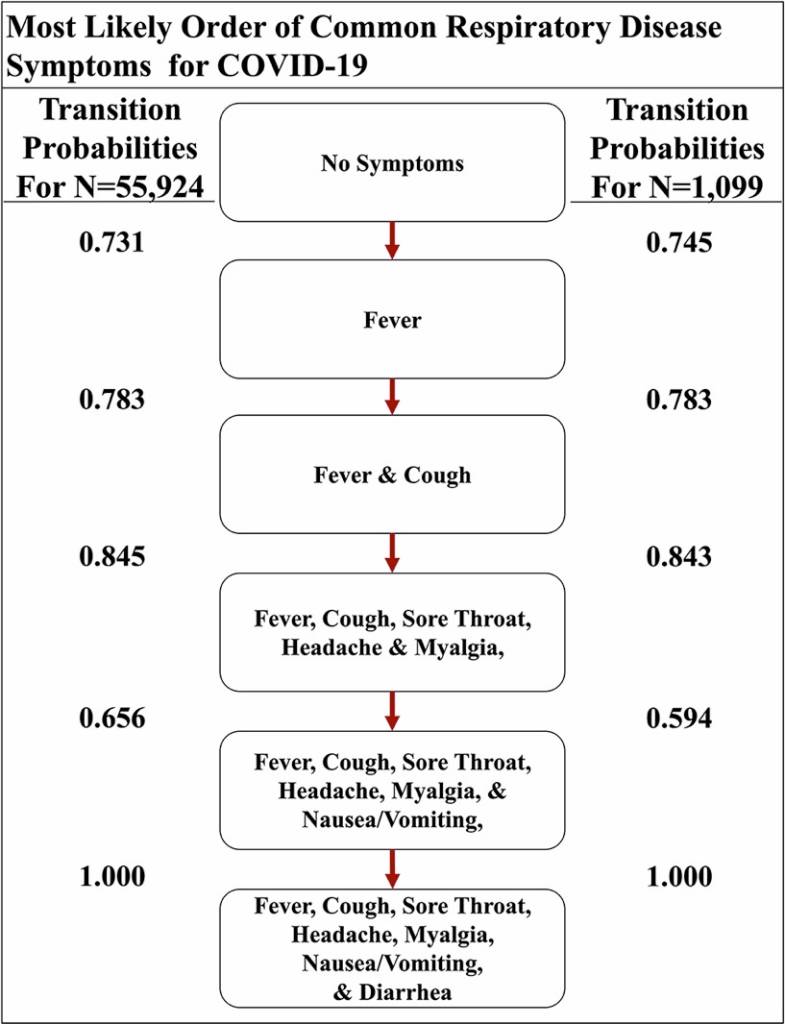- A new study provides a key detail surrounding coronavirus symptoms, the likely order in which COVID-19 signs appear in infected patients.
- The timeline of COVID-19 symptoms could help patients better educate themselves and seek medical care earlier than they might have otherwise, so they can avoid spreading the disease.
- Knowing the order in which coronavirus symptoms typically present could also be very useful for healthcare workers, who would be able to better distinguish COVID-19 patients from others.
One of the things that make is so difficult to contain the novel coronavirus pandemic is COVID-19’s symptomatology. The incubation period can last from a few days to two weeks, so you might not start showing the first signs of infection until long after you caught the disease. That is if you experience any symptoms at all. Many people get the virus but don’t develop signs that would warn them something isn’t right and that testing, isolation, and treatment might be necessary. If you do experience symptoms, they won’t be enough to definitively diagnose your illness as COVID-19 without a PCR test. The novel coronavirus does induce one particular symptom that’s seen as clear evidence of infection with the novel coronavirus, and that’s the sudden loss of smell and taste. The problem is that not all the people who get infected experience this telltale sign.
While symptoms may not be enough to diagnose COVID-19 correctly, knowing what the most likely coronavirus signs are, and the order in which they appear, could be a helpful tool for patients and doctors alike. For the first time since the start of the pandemic, a team of researchers analyzed thousands of COVID-19 cases and figured out the likeliest order of COVID-19 symptoms.
“This disease is more contagious than influenza such that cluster outbreaks occur frequently,” the researchers wrote in a study published in Frontiers in Public Health. “If patients with symptoms quickly underwent testing and contact tracing, these outbreaks could be contained. Unfortunately, COVID-19 patients have symptoms similar to other common illnesses.”
The researchers continued, “We hypothesize the order of symptom occurrence could help patients and medical professionals more quickly distinguish COVID-19 from other respiratory diseases, yet such essential information is largely unavailable.”
The USC Michelson Center for Convergent Bioscience team analyzed data sets from more than 55,000 COVID-19 cases in China that the World Health Organization (WHO) collected in mid-February, as well as data for nearly 1,100 cases from December 11th through January 29th collected by the China Medical Treatment Expert Group via the National Health Commission of China. They compared the evolution of symptoms in COVID-19 with influenza, SARS, and MERS, although it’s the flu that matters most for this type of study.
Through their analysis, the researchers found that COVID-19 patients who develop symptoms are more likely to experience fever first, followed by cough and muscle pain. Then nausea and vomiting might set in, and only later would diarrhea appear.

The researchers also added sore throat, myalgia, and headache to the original set of symptoms. They found that “these additional [more subjective] symptoms did not perturb our initial ordering of fever, coughing, nausea/vomiting, and diarrhea, but instead added another level of intricacy in the middle of the likely paths.” The study indicated that either one, two, three, or none of the subjective symptoms might appear before nausea/vomiting and diarrhea. Should diarrhea be the first symptom, the researchers believe that the patient might experience a more severe case.
“This order is especially important to know when we have overlapping cycles of illnesses like the flu that coincide with infections of COVID-19,” study co-author Peter Kuhn told ABC News. “Doctors can determine what steps to take to care for the patient, and they may prevent the patient’s condition from worsening.”
For comparison, here is the most likely order of symptoms for the flu, SARS, and MERS, from the same research:

There’s no guarantee that all COVID-19 cases will start with fever, and many people do not even experience that symptom at all. Similarly, there’s no guarantee that all infected persons will go through these symptoms in this particular order, and more research on the matter is needed to confirm the findings. But these early conclusions could be helpful, especially in hospitals that are dealing with large COVID-19 caseloads and are bracing for the flu season to hit. Understanding the order of symptoms could make a key difference in how healthcare workers approach patients with COVID-19 this flu season.
“Given that there are now better approaches to treatments for COVID-19, identifying patients earlier could reduce hospitalization time,” Joseph Larsen said. Also, the researchers think the fact that fever is the most common first symptom is a confirmation that temperature checks should be conducted in schools and other indoor settings.








